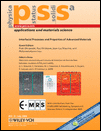Laser assisted fabrication of Co on Ti–6Al–4V for bio-implant application
Abstract
In the present study, attempts have been made to fabricate a Co layer on the surface of Ti–6Al–4V substrate by laser assisted fabrication technique with an objective to develop compositionally graded hip and femoral prostheses. Laser processing was carried out by melting of Co powder (of 25 μm particle size) with a continuous wave CO2 laser and depositing it on Ti–6Al–4V substrate in a layer by layer fashion using Ar as shrouding environment to avoid oxidation. The process variables were applied power density, scan speed and number of layers. During the development of 1st layer, laser power and scan speeds were varied to develop a compositionally graded interface, following which the successive layers were formed. A detailed microstructural study of the fabricated layers was carried out to understand the influence of laser parameters on microstructure. X-ray diffraction study and energy dispersive spectroscopic analysis were undertaken to see if non-equilibrium cooling associated with the process has caused formation of any new phase or segregation of elements in the microstructure. Following characterization, the mechanical property (wear resistance) and electrochemical property of the fabricated components have been evaluated. (© 2006 WILEY-VCH Verlag GmbH & Co. KGaA, Weinheim)




